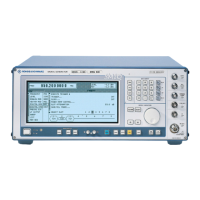Fading Simulation SMIQ
1125.5555.03 2.72 E-9
2.9.3 Correlation between Paths
Fading processes of different paths normally do not depend on statistical processes. However, it is
possible to set a correlation of paths 1 to 6 with paths 7 to 12 in pairs. To set the correlation, a synchronous
signal processing is required for the two fading options which involves the following restrictions:
• The correlation is always reciprocal, ie if path 1 is correlated with path 7, path 7 is also correlated
with path 1 (CORR PATH).
• The following parameters of the two paths have to correspond:
- Fading profile PROFILE
- Doppler parameter SPEED or DOPPLER FREQ
- Magnitude of correlation coefficient COEFF
• The following equation applies to the phase of the correlation coefficient and thus to the phase shift
between the correlated paths:
ϕ
12
= 360° - ϕ
21
• The parameters for Log Normal fading have to correspond for correlated paths.
All parameter adaptations due to the limitations mentioned before are automatically performed by SMIQ.
Note: After setting all parameters, the two fading options have to be synchronized by RESET and
then by RUN.
2.9.4 Menu FADING SIM
Fig. 2-38 Menu FADING SIM with submenus
FADING SIM
Selection of fading simulator mode.
STANDARD FAD "Normal“ mode with 6 paths (with option SMIQB14) or 12
paths (with SMIQB14 and SMIQB15), time resolution 50 ns.
FINE DELAY Mode with fine time resolution. Two paths are possible for
each option (SMIQB14 / SMIQB15). The system bandwidth
of the paths is limited to 4.6 MHz; this is sufficient for 3GPP
with 3.84 Msymb/s. Time resolution is 1 ns.
MOVING DELAY Mode with 2 paths, one with a fixed delay, the other with
a delay varying sinusoidally. This corresponds to test
case 3GPP, 25.104-320, Annex B3.
BIRTH-DEATH Mode with 2 paths with a delay randomly varying within a
time range.
Note: The modes FINE DELAY, MOVING DELAY, BIRTH-DEATH are
possible only if software option SMIQB49 is built in.

